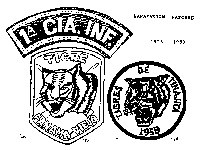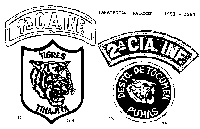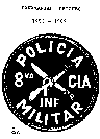
This is the first in a series of articles on the patches of Panama's armed forces. The time frame for this subject covers from 1953 to 1989 and encompasses approximately 200 embroidered insignia.
Panama has done without an army for most of it's history, one year after Panama's 1903 creation, the first army was abolished. In 1953 the National Police became the Guardia Nacional (National Guard), reinstating the Army. Later the main combat arms components were renamed "Fuerzas de Defensa (de la Republica de) Panama" which somehow ends up being abbreviated FFDD, usually referred to in the west as the Panamanian Defence Forces (PDF).
The first reference to the PDF comes in a speech Noriega gave at Fort Amador during his assumption of command ceremony of the Guardia Nacional, 12 August 1983. Law of the Republic Number 20, of September 29, 1983 confirms and legalizes the name change. The name probably comes from Noriega's admiration of the Israeli Defence Forces. Although a PDF component, the police retained the Guardia Nacional title, and most civil agencies, as they were absorbed into the PDF were also placed under the Guardia Nacional. This greatly expands what patches can be considered "military".
For the purposes of these articles, a basic black and green patch will be called "Subdued", while a basically subdued patch with some colour, like the U.S. Air Force non-full colour patches, will be "Muted". "Twill" refers to the type of patch that is not fully embroidered, where the colour of the background cloth serves as the background colour, the embroidery not completely covering the entire patch. This term is common usage, at least in the U.S., although the background cloth is rarely real cotton twill.
This first article will cover the eight numbered infantry companies of the army, Panama had 4 battalions late in its history, which were made up of some of the eight historical numbered infantry companies, and added several titled companies which rarely had a patch. As the oldest units, the numbered companies had the greatest variation of patches. these patches were usually seen on headgear and later migrated to the sleeve when worn on the sleeve it was on the right side, usually under an arc.
The arcs were the most common sleeve insignia in the early days of the G.N., most arcs, which are gold on red twill, seem to come in an early Panamanian made version with sides sloped at about a 45 degree angle. These were worn alongside a newer type arc, also Panama made, with straight sides. Many Panamanian made patches can also be found in two slightly different versions, apart from the "U.S." made patches, the different versions of the areas and patches seem to be from when the older "cartoon" driven loom was replaced with a computer operated loom.
Later patches also seem to come in two mostly identical versions - a Panamanian made cut edge patch and a "U.S." made version with a merrowed edge, although most "old hand" collectors refer to the merrowed patches as being "U.S. made", more than likely they were contracted by a U.S. company and really made in Asia. The one main (and only surviving) Panamanian patch company is capable of producing a merrowed patch but appears to have mostly done so for patches contracted for by the U.S. Army, in order to meet U.S. government specifications. The few merrowed arcs that exist do not seem to be Panamanian made. A very few fully embroidered straight sided U.S. made infantry company arcs seem to have been made, at least for the 1st Company, in the mid 1960's.
The Panamanian patch company makes patches for over 12 nations and has recently won worldwide competitions for the quality of its work.
Illustrations:
 Fig. 1A: 1st Company TIGRE, created on 12 May 1959.
Patch was worn with a gold on red are "la CIA.INF." (all
Infantry Company arcs were in these colors unless
subdued). This unit was later a Fire Support Element of
Battalion 2000, and was located in the 11th Zone, San
Miguelito. This patch reflects the unit name and
location at Old Panama, letters are gold, tiger is in
five colors, behind the head are two crossed rifles in
black, all on a green twill.
Fig. 1A: 1st Company TIGRE, created on 12 May 1959.
Patch was worn with a gold on red are "la CIA.INF." (all
Infantry Company arcs were in these colors unless
subdued). This unit was later a Fire Support Element of
Battalion 2000, and was located in the 11th Zone, San
Miguelito. This patch reflects the unit name and
location at Old Panama, letters are gold, tiger is in
five colors, behind the head are two crossed rifles in
black, all on a green twill.
Fig. 1B: 1st Company TIGRE: A fully embroidered version developed for beret wear late in the unit's life.
 Fig. 1C: 1st Company TIGRE:
This patch is the definitive PDF era shoulder patch and
unit symbol and like the round patch has black letters
on a green background, a 4 colour tiger head.
( A composite of the two shield shaped patches from the
mid-1960's is illustrated in the 1968 regulations and
seems to have come in a Panamanian made twill version
and a (confirmed) U.S. made fully embroidered version.
This patch is not illustrated but it had a rounded
top, tiger head in front of crossed rifles, a gold
border with green background and black legend "TIGRE"
at the top and "PANAMA VIEJO" at the bottom.
Fig. 1C: 1st Company TIGRE:
This patch is the definitive PDF era shoulder patch and
unit symbol and like the round patch has black letters
on a green background, a 4 colour tiger head.
( A composite of the two shield shaped patches from the
mid-1960's is illustrated in the 1968 regulations and
seems to have come in a Panamanian made twill version
and a (confirmed) U.S. made fully embroidered version.
This patch is not illustrated but it had a rounded
top, tiger head in front of crossed rifles, a gold
border with green background and black legend "TIGRE"
at the top and "PANAMA VIEJO" at the bottom.
Fig. 2A: 2nd Company PUMA, created 14 May 1959:
This unit was latter the airborne part of battalion 2000 and was stationed at Tocumen Airport. This older patch has gold letters on maroon twill with a five colour puma head.
 Fig. 2B: 2nd Company PUMA:
A latter Panamanian made patch which is fully
embroidered, a white outer border with black inner
border, maroon-orange background, 3 colour puma head
(orange, white and brown with a red tongue) with gold
letters.
Fig. 2B: 2nd Company PUMA:
A latter Panamanian made patch which is fully
embroidered, a white outer border with black inner
border, maroon-orange background, 3 colour puma head
(orange, white and brown with a red tongue) with gold
letters.
Fig. 3A: 3rd Company Diablo Rojo, created 10 March l969: This was part of the 5th Zone and stationed in David, Chirique Province, the patch was often seen on a red beret. The design of the patch has not changed since the unit was created, the devil being red with black hair and wings, horns red, on a light blue background, on U.S. made patches, which are otherwise identical, the light blue is blue, black border, red unit title on yellow field. A subdued version is known.
 Fig. 4A: 4th Company URRACA, created on 14 February 1969
Stationed at El Chorrillo Neighbourhood, Panama City, as
a guard to PDF Headquarters. Also seen as a subdued
version on a mint green beret, the wearing of the
coloured patch on the beret was probably for dress. This
older shield shaped patch has black borders letters and
indian hair, flesh colour for head and shoulder, on a
red twill background, with a normal coloured infantry
arc.
Fig. 4A: 4th Company URRACA, created on 14 February 1969
Stationed at El Chorrillo Neighbourhood, Panama City, as
a guard to PDF Headquarters. Also seen as a subdued
version on a mint green beret, the wearing of the
coloured patch on the beret was probably for dress. This
older shield shaped patch has black borders letters and
indian hair, flesh colour for head and shoulder, on a
red twill background, with a normal coloured infantry
arc.
Fig. 4B: 4th Company URRACA: This later fully embroidered version has gold letters with a red, white, black outer border, the indian head being of flesh colour with black hair, red head-band and two green feathers, the background colour is red. It has been seen to be worn with two types of arc, both gold letters on red field but one type having "4aCIA.INF" the other "4aCIA.URRACA". A small camouflage patch of the same basic design but with the warrior facing left and the addition of the legend "Commando" existed, this was also worn as a beret badge.
A seemingly related version of this patch surfaced recently, with the Indian head facing the viewer's left in full profile, the word "Urraca" at the top and what appeared to he a pair of crossed War clubs" behind him. This turned out to be the patch of a Nicaraguan baseball team that was sponsored by (then) Chief of Staff Col. Roberto Diaz-Herrera, the design was taken verbatim off the Panama 1 cent coin, except for the added baseball bats (war clubs). This patch may account for the persistent rumours of a "combat" patch worn by Panamanian volunteers who fought in Nicaragua.
The unit's name refers to an Indian warrior who resisted the early Spanish. This unit was involved in a coup attempt against Noriega on 3 October 1989, subsequently the enlisted were dispersed among other units and the officers killed. This insignia was removed from anywhere that it had been displayed, its place in the E1 Chorrillo (along with elements from other units) was taken by the Machos de Monte, who were flown in during the coup to rescue Noriega. El Chorrillo, an especially poor slum, was destroyed along with the Commandancia (which included military clothing) during operation "Just Cause".
 Fig. 5A and 5B: Military Police, 5th Company of Infantry
VICTORIANO LORENZO, created 14 January 1970, stationed
at Fort Amador in Panama City: 5a. is the U.S. made
version with the "INF" which is left out of the
Panamanian made patch, fig.5b, all colour versions of
the patch were gold on black twill with the crossed
machete (handle in gold) and M-16 in white. An older
Panamanian made version of this patch has a roman number
"V" in place of the "5" and also lacks the word "INF".
Fig. 5A and 5B: Military Police, 5th Company of Infantry
VICTORIANO LORENZO, created 14 January 1970, stationed
at Fort Amador in Panama City: 5a. is the U.S. made
version with the "INF" which is left out of the
Panamanian made patch, fig.5b, all colour versions of
the patch were gold on black twill with the crossed
machete (handle in gold) and M-16 in white. An older
Panamanian made version of this patch has a roman number
"V" in place of the "5" and also lacks the word "INF".
The subdued patch of the 5th Company can be found on a U.S. style green cloth arm),and (brassard) with letters "PM" in black plastic. The dress brassard was black with white letters. A subdued 5th Company arc is known. The 5th Company cadre who went to the Atlantic side to form the 8th Company wore a red twil1 version of the 5th Company patch with a "Gulick" tab under the patch. The gold on black arc, "VICTORIA LORENZO", was worn in the early days of the unit on headgear and probably on the sleeve as well. The 5th and 8th Companies were called collectively the Military Police Battalion.
 Figs. 6A and 6B: 6th Company EXPEDICIONAPIA MECHANIZADA
created 14 June l974, stationed at Rio Hato in the Coele
Province.
Both are fully embroidered patches, the arc being in the
normal red twill field with gold edge and legend, the
patches have a gold coloured background with a black
border, a green map of Panama surmounted by crossed
M-16's in grey high-lighted in black, the unit titles
letters in red, fig. 6b. is the smaller version that was
worn on headgear. A subdued "COMPANIA EXPEDICIONARIA"
arc has been seen.
Figs. 6A and 6B: 6th Company EXPEDICIONAPIA MECHANIZADA
created 14 June l974, stationed at Rio Hato in the Coele
Province.
Both are fully embroidered patches, the arc being in the
normal red twill field with gold edge and legend, the
patches have a gold coloured background with a black
border, a green map of Panama surmounted by crossed
M-16's in grey high-lighted in black, the unit titles
letters in red, fig. 6b. is the smaller version that was
worn on headgear. A subdued "COMPANIA EXPEDICIONARIA"
arc has been seen.
 Fig. 7A and 7B: 7th Company MACHO DE MOUTE, created 7 April
1969, stationed at Rio Hato.
In the late days of the PDF this was an
"Anti-guerrilla" unit, and used as muscle where and
when needed.
The patch is is of 3 colours, a red twill field with a
white border, letters in black, skull and crossed
machetes in white with black handles, out-lines on both
in black. Fig. 6a is the old G.N. style patch while 6b.
is the PDF version, differing only in the loom used and
thickness of skull.
Fig. 7A and 7B: 7th Company MACHO DE MOUTE, created 7 April
1969, stationed at Rio Hato.
In the late days of the PDF this was an
"Anti-guerrilla" unit, and used as muscle where and
when needed.
The patch is is of 3 colours, a red twill field with a
white border, letters in black, skull and crossed
machetes in white with black handles, out-lines on both
in black. Fig. 6a is the old G.N. style patch while 6b.
is the PDF version, differing only in the loom used and
thickness of skull.
In the first years of the unit the patch had been made in error with crossed bones rather than crossed machetes. The arc was made in subdued but like the 1st and 2nd Companies, the unit patch is not known to have been subdued. Although the unit title translates literally as "Men of the Mountain", this referred to a Tapir, although in PDF times the implication of being "Macho" was used to effect. Members wore beards, supposedly in emulation of Che Guvarra, as the unit was later Cuban trained and influenced. This unit were manning a road block near the Commandancia when a U.S. Marine Captain forced a road block, leading to one of his passengers, a Marine 1st Lieutenant Robert Paz, being shot and killed. A U.S.N. Lieutenant (a member of the elite "SEAL's") and his wife witnessed it and they were detained by the Machos. They beat up the Lieutenant and abused his pregnant wife, after being briefed about these latest incidents on U.S. personnel in Panama by Noriega's troops, the U.S. President Bush decided to put into effect "Operation Just Cause".
 Fig. 8: Military Police, 8th Company of Infantry, created from
a platoon from the original 5th M.P. Company, stationed
at Fort Gulick (Espinar).
Its patch is large, on blue twill, red unit title and
letters, white crossed M-16 and machette red outer
border. A white letter variant, probably U.S. made, is
known, as is a Panamanian made subdued version.
Fig. 8: Military Police, 8th Company of Infantry, created from
a platoon from the original 5th M.P. Company, stationed
at Fort Gulick (Espinar).
Its patch is large, on blue twill, red unit title and
letters, white crossed M-16 and machette red outer
border. A white letter variant, probably U.S. made, is
known, as is a Panamanian made subdued version.
Back to Table of Contents -- El Dorado Vol VII No. 2
Copyright 1996 by The South and Central Military Historians Society